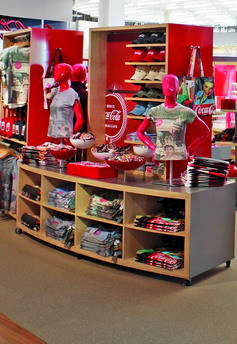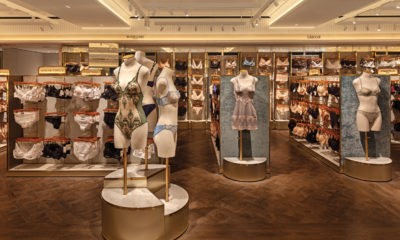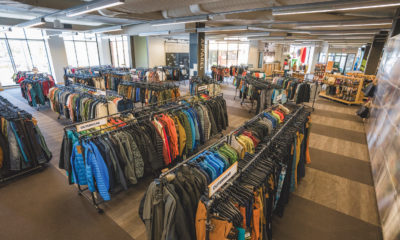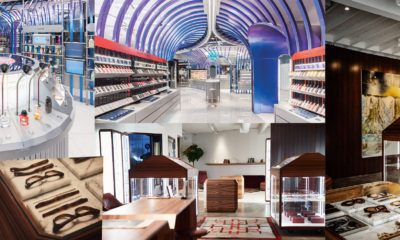Designers and planners of the Coke Store in the new World of Coca-Cola exhibit (at the company’s Atlanta headquarters) had very specific requirements for their store fixtures: durable, flexible, cost-efficient and eco-friendly.
The finished project is a blend of a sleek modular perimeter system and raw, rougher-looking, high-capacity loose fixtures. They present a great deal of merchandise without crowding up the 9000 square feet, which have to be open enough to accommodate the expected 6000 visitors a day. And they have to absorb the wear and tear those 6000 visitors will bring without looking worn and used. They also had to fulfill the ecology-driven theme of the store, “Recycle. Repurpose.” Coke is seeking gold LEED certification for the project.
How all that fixturing got there, though – from brainstorming to completion – is a glimpse of what goes into putting a store together in the 21st Century. Today, more than ever, retailers face an array of store fixture manufacturers able to do all manner of custom work using nearly all surface materials – and often at nearly any price. The consolidation of the industry in North America has been balanced (some would say caused) by a proliferation of overseas manufacturers, especially in Asia – and, most specifically, in China. Equipment technology and access to materials has proved to be as good there as here, and more lax labor laws allow companies to produce the same fixtures at lower prices. The cost, distance and complexity of shipping large fixtures across the ocean in time to meet retailers’ tight deadlines has so far not been a major problem.
What has been a problem for retailers, however, is identifying the right suppliers at the right prices for the right job, so the complexities of the job do come together and schedules and budgets are met. Veteran store planners know what North American suppliers can and can’t do, but not all Chinese manufacturers have the same capabilities as one another. Someone with a foot in both continents has to know what to hold and when to fold. That has led to the growth of turnkey fixture consultants who understand both manufacturing and retailing issues and who are willing to consult on design and manufacturing specs, participate in reverse auctions and get on airplanes to supervise jobs and make sure problems are headed off.
In the case of the World of Coke store, Pompei A.D., the New York-based design firm on the project, had created the system concept that the Coke retail people were looking for. Now they needed to make the system a reality – the look, functionality and cost. They called in Jonathan Glanz of J. Glanz Associates (Ho-Ho-Kus, N.J.), who went into business six years ago to handle just such complex jobs. Store fixturing is in his DNA; his uncle, Jay Austrian, and his mother, Jackie Glanz,.run in Central Islip, N.Y. Glanz sold for MG Concepts before branching out to represent European companies Visplay Intl. (Birsfelden, Switzerland) and Umdasch Shop Concept (Neidenstein, Germany) in the U.S. He also sold the Visplay system on behalf of Marlite (Dover, Ohio), which had an agreement with the German company.
“Services like mine serve as a bridge between the drawing board and the real world,” Glanz says. “Most architects don’t have the expertise to specify materials, hunt out new manufacturing techniques, do the value engineering with the manufacturer and install the finished product.”
Pompei’s design renderings for Coca-Cola had called for a socket system in the fixtures’ tabletops. Glanz brought in four manufacturers’ systems and evaluated the prices, functionality and aesthetics. The metal cladding was to have a raw steel look, but real raw steel rusts and a clear coating didn’t look right, so Glanz and the manufacturers brainstormed and came up with a chemically washed steel from Asia.
“We had to become the designers’ eyes and ears,” he says, “the go-to guy who could find the right vendor, the one with rthe special resin or the artist in Brooklyn.”
Once Coke approved the prototypes, Glanz oversaw the shop drawings, production runs, review of materials and colors and installation. And, while much of the manufacturing was being done in China, Glanz lined up local suppliers. “Issues happen,” he says. “You have to be able to react locally if problems suddenly arise 7000 miles away.


 Photo Gallery1 week ago
Photo Gallery1 week ago
 Headlines4 days ago
Headlines4 days ago
 Headlines1 week ago
Headlines1 week ago
 Headlines2 weeks ago
Headlines2 weeks ago
 Headlines2 weeks ago
Headlines2 weeks ago
 Designer Dozen1 week ago
Designer Dozen1 week ago
 Headlines1 week ago
Headlines1 week ago
 Headlines3 days ago
Headlines3 days ago












